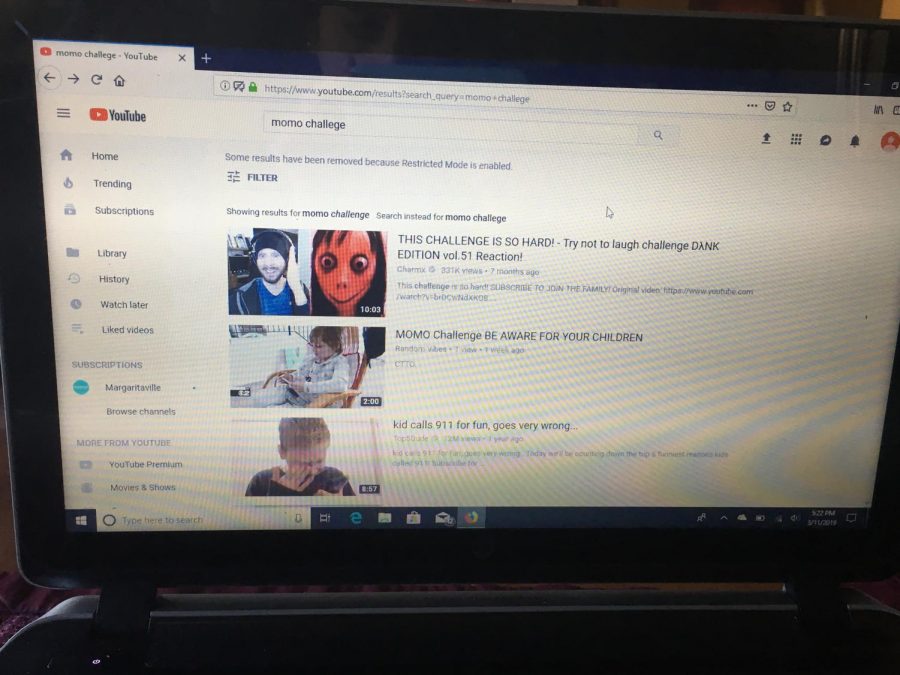Momo is not just a danger for kids
The Momo challenge on YouTube.
Momo has swept over social media, creating a viral panic among parents as they link the dangers between young children and the internet. The creepy eyed figure called “Momo” supposedly appears in the middle of videos on YouTube and encourages viewers to harm themselves. It came as a shock when Momo was deemed a hoax. Adults became panicked because of an imaginary cartoon, revealing and underlying issue of parents not monitoring what their children view online.
The image of Momo first appeared from a sculpture by Japanese artist Aisawa. The image then made its way to Instagram and other social media platforms. Eventually a false media challenge arose, where Momo would appear randomly during YouTube videos and online urging viewers to participate in dangerous challenges. These challenges escalate to Momo telling kids to commit suicide. It was soon revealed that Momo never existed in the way people believed.
“We want to clear something up regarding the Momo Challenge. We’ve seen no recent evidence of videos promoting the Momo Challenge on YouTube. Videos encouraging harmful and dangerous challenges are against our politics,” tweeted YouTube on February 27th.
YouTube followed that tweet by encouraging viewers to flag videos that promote harmful or dangerous challenges. On February 28th, YouTube released a video updating users on recent action they have taken to protect the safety of young people.
“No form of content that endangers minors is acceptable on YouTube, which is why we have terminated certain channels that attempt to endanger children in any way…We will continue to take action when creators violate our policies in ways that blatantly harm the broader user and creator community,” stated YouTube.
The North Penn School District sent out an email on February 28th warning parents in the community about the dangers of The Momo Challenge. Various links were provided to websites pertaining to internet safety and parenting in the digital age.
“We encourage you to consider family guidelines for appropriate use of technology. We suggest that you consider age appropriateness for children’s use of technology, time spent on social media, and overall reminders of family expectations for making good choices,” said Superintendent of NPSD, Dr. Curtis Dietrich.
Many challenges similar to Momo go viral at some point. The cinnamon challenge was a popular act a few years ago. The Tide Pod eating challenge and condom snorting challenge were also online trends in 2018. All of these challenges were posted on social media, generating hundreds of thousands of views. The major difference with Momo is that there is no evidence of it popping up in random Peppa the Pig videos telling kids to kill themselves. Parents created the urban legend of Momo with panicked sharing on Facebook, proving just how easy it is to manipulate some parents and their minimal knowledge about internet predators.
“I read this really awesome research piece once [saying] when a parent gives a child unrestricted access to the internet, it’s like dropping them in the middle of a black, darkened warehouse in the middle of Manhattan and hoping nobody else is there. You hope nobody else harms them, but you have no idea what that warehouse is full of,” explained English teacher Megan Schmidt.
Schmidt has two children of her own who have access to the internet through an iPhone or iPad. She encourages all parents to educate their children about online safety and believes that no child is ever too young to learn about the importance of safe online habits.
“I think if you’re always talking to your kids about what they see and to be savvy consumers of media, you’re teaching them more than just how to be safe,” added Schmidt.
There are a lot of dangers online that children can gain easily access to without parental supervision. Most parents currently raising kids did not grow up with the internet at their fingertips. Raising children is now a whole new game.
“Really it’s about teaching your kids to be good people. If [kids] are looking at something or watching something and [kids] know they shouldn’t be, then it needs to be put away or turned off,” says Schmidt.
The internet has opened a door leading to more dangers for children. Parents are equally responsible as children to educate themselves about what is actually dangerous on the internet. Predators now hide behind computer screens, webcams, and fake usernames. The cautionary tale of never accepting candy from a stranger in a van is no longer the only risk for kids.



Nicholas Springer (Dinosaur King 2016) • Mar 13, 2019 at 11:50 am
What is this a thing this is worst than the tie pods challenge or any thing before this
#WHAT






